Menu
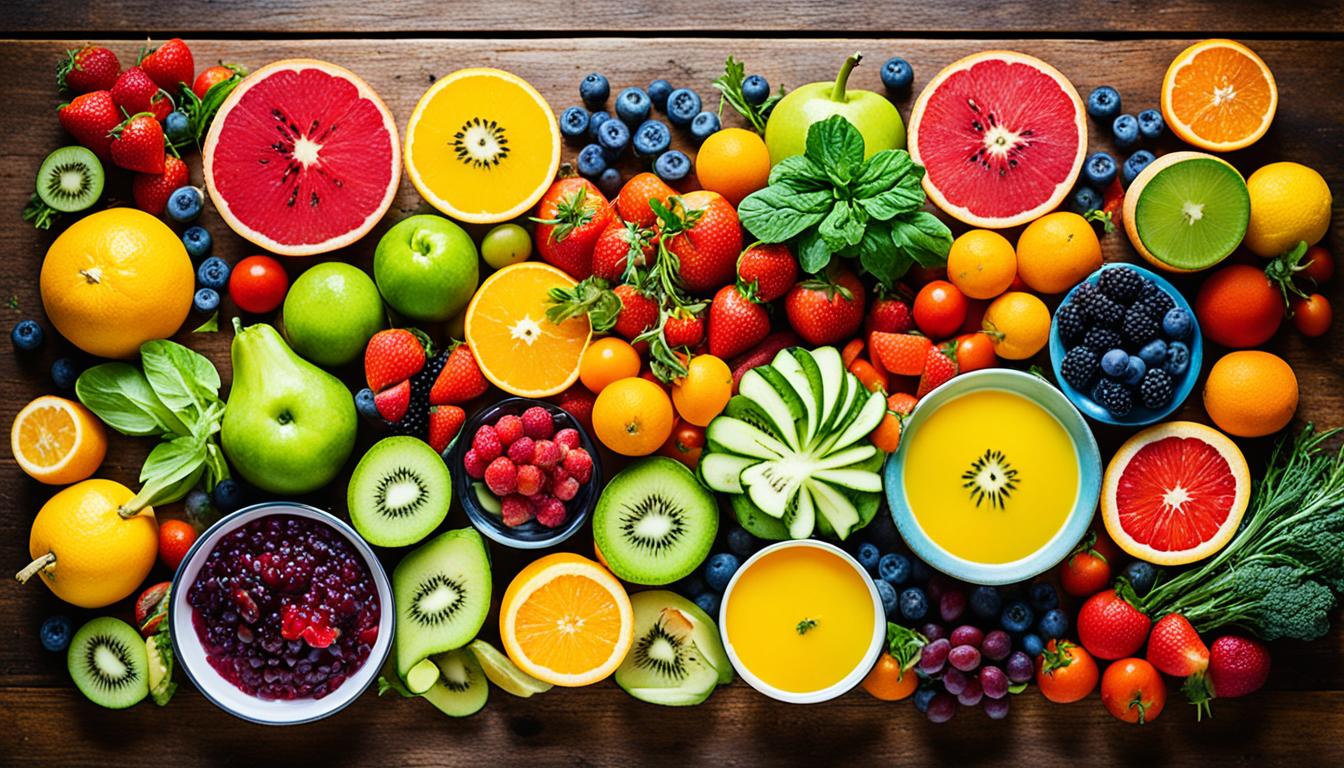
Have you heard about “farm to table”? It brings food from the farm to your plate fast, keeping the taste fresh and full. This way of eating comes from buying directly from local farms. It helps local farmers and brings delicious meals to our tables. In my kitchen, I use this method to cook with the best of each season’s fruits and veggies.
I’m all for farm-to-table meals. My kitchen is always colourful with fresh food from the nearby farmers’ markets. I use things like juicy peaches for salads and crispy zucchini for fritters. Having a farm-to-table cookbook shows how much I love cooking with what each season gives us.
Each dish I make is a nod to the time of year. Like, for spring, I bake rhubarb cakes that taste amazing. In summer, a salad with blueberries and chicken is perfect. It’s all about bringing out the best in fresh food, and they’re healthy and delicious too.
Farm-to-table cooking reflects the heart of my kitchen. It’s about bringing farm food straight to your plate. This means meals are not only fresh but also support local farmers. I love knowing where my food comes from. It inspires my cooking and makes every meal special.
The farm-to-table movement wants us to eat more like our ancestors did. It began as a response to food travelling long distances in the 20th century. This movement focuses on food from small, local farms. It helps support our agriculture and protect the environment.
Eating food that’s grown nearby is tastier and better for you. Fresh fruits and veggies keep their nutrients when you eat them soon after they’re picked. Also, they are less likely to have harmful chemicals on them. Knowing how to store them right also keeps them fresh longer.
Simple ways of cooking can make local goods taste amazing. From roasts to grilled dishes, everything is delicious when it’s fresh. Restaurants are loving local salads and homey soups made with fresh veg. I prefer meals like fried eggplant or veggie pasta, showing off what local food can do. Pair any meal with simple sides for a complete and tasty dish.
Farm-to-table means plenty of foods that are good for you. They’re packed with things your body needs like fibre and vitamins. These foods help fight off illnesses, including cancer. Yes, there may be some hurdles like cost and availability. But the big wins for your health and the planet are totally worth it.
Choosing local ingredients is not just about great taste. It’s about supporting the environment, local farmers, and your community too.
Local produce is fresher and tastier. The fruits and vegetables are picked when perfectly ripe. They keep their natural flavour and nutrients. Heirloom tomatoes, for example, taste much better when they’re not shipped over long distances. About 73% of people say local foods are fresher and of higher quality.
Picking local produce supports more than my health. It helps local farmers and the community. Buying directly from them helps keep the business local. It also ensures the land is used responsibly. Many consumers, roughly 60%, see this as important. It makes my food experience more meaningful.
Locally sourced food means less pollution from transporting it. Shorter food journeys are better for the planet. This farm-to-table method can cut down pollution by 25%. It helps keep our environment clean.
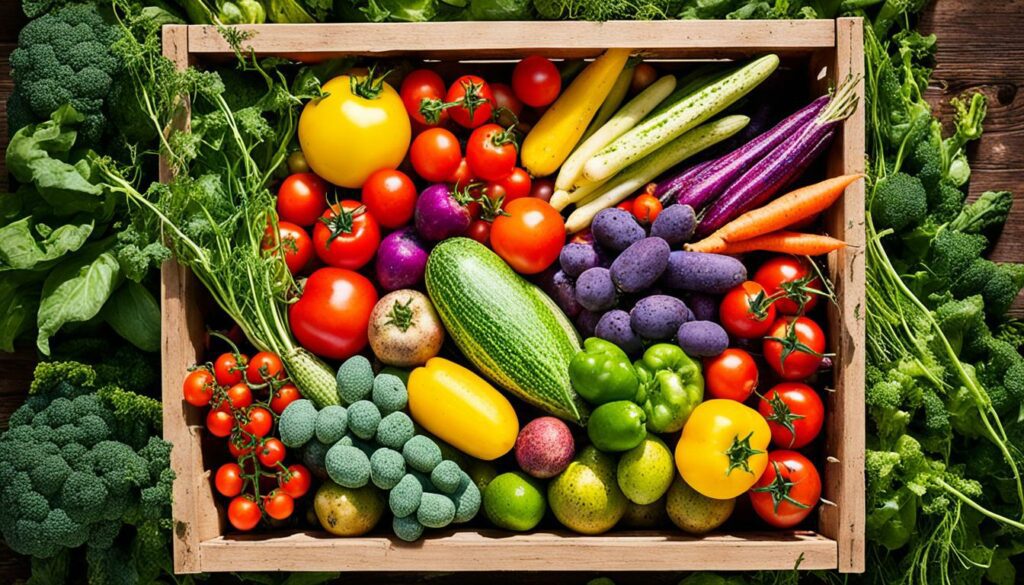
Nature’s calendar guides my cooking. It maps out the freshest experiences each season has. By using this guide, every meal is full of lively flavours from fresh, seasonal food. Discover the unique marks of each season’s harvest to inspire your cooking.
Spring is bustling with fresh goods from nearby farms. Seasonal favourites like asparagus, strawberries, and scapes shine in dishes. Try a Niçoise salad with green beans and radishes or a pasta with leeks and asparagus. Spring’s items make meals special.
Summer brings ripe peaches, snap peas, and colourful fruit. My Grilled Peach Salad highlights these gems. A quick Margherita pizza with spinach and artichokes turns everyday moments gourmet. It brings out summer’s best tastes.
In autumn, hearty pumpkins and mushrooms hit the kitchen. Root veg and squash are stars, making warm, comforting meals. These ingredients infuse dishes with deep, rich flavour. Autumn meals become soulful events.
Winter offers up a mix of strong greens and citrus. Root veg like parsnips boost nutrition in my recipes. Even in winter, our tables are lively with fresh food. Local production keeps our plates colourful.
Throughout the year, I support local farmers for top-quality ingredients and sustainable farming. This journey also supports local economies. Seasonal cooking brings the best of each season to my table.
Every farm-to-table dish starts with a commitment to good farming practices. Practices like regenerative agriculture help the soil and boost diversity on farms. This supports an ecosystem where everything is important for balance.
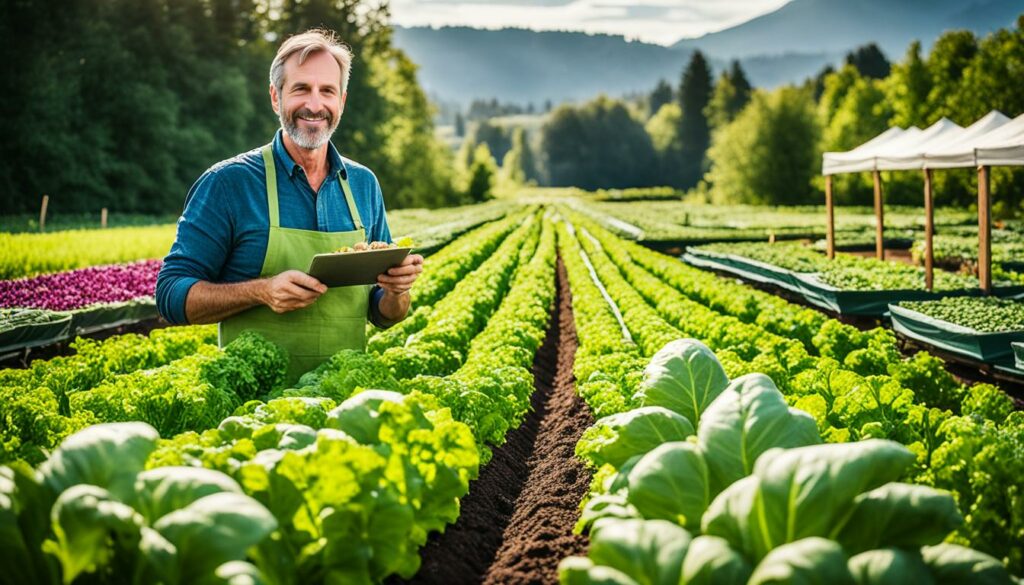
Pesticide-free cultivation focuses on rotating crops and using organic methods. This keeps the land fertile and productive. Pick foods from such farms for nutritious and planet-friendly meals.
Menus that source local ingredients cut back on using fossil fuels for transport. This reduces greenhouse gas emissions and brings us fresher foods. Backing local farmers help rural communities in the US to grow and last.
By buying food directly from farmers, we get fresher and better-tasting meals. This can be meat from pastured operations or veggies grown with care. Our food’s quality and flavour improve a lot.
To sum up, eco-conscious farming and biodiversity in farming benefit the environment and what we eat. By picking ingredients grown sustainably, we respect the land and those who farm it. Plus, we get to enjoy healthy and tasty meals.
The journey from the farm to your plate is what the farm-to-fork ethos talks about. This way of thinking started becoming popular in the 1960s and 70s. It aimed to jazz up American kitchens with lovely, fresh food straight from the farm. Chez Panisse, started in 1971 by Chef Alice Waters, is seen as a key place in developing this tasty idea.
The farm-to-table idea began slowly and quietly. People wanted fresher, more local food. By the 2000s, it was big news, especially in places like Boulder, Colorado and Seattle, Washington. This way of eating has quickly become one of the top food movements in the U.S. This shows we’re all learning how important it is to eat food that’s grown nearby.
Eating locally helps our communities and the economy. Local food sourcing means meals are prepared with the freshest ingredients. Also, it’s great for our planet. By buying food that doesn’t travel far, we cut down on polluting gas. That’s a win for everyone.
Still, eating straight from the farm does have its downsides. Seasonal menus can be hard for some restaurants to keep up with. People want to be sure that the farm-to-table places they eat at are truly using local food. And, helping small farmers by paying more for their work can mean your meal costs a bit more. While a few businesses might just be following a trend, many really do care about where their food comes from.
Many groups, including the Food Network, stress the value of super fresh food and the need to support local farmers. They advise on a whole range of dishes, from simple meals at home to fancy dining out. These folks are all about conscious consumption. They want us to think carefully about the food we eat and where it comes from.
To sum it up, the farm-to-table trend has gone from something small to something huge. It mixes great tasting food with good-for-the-earth choices. This movement reminds us to care about the food we eat and where it comes from. It’s all about sharing the true story of how our food gets to our plates.
In the world of summer salads, the Grilled Peach and Heirloom Tomato Salad shines. It blends the sweet smokiness of peaches with tangy tomatoes. This mix captures the best of summer’s bounty. It fuses the classic taste of tomatoes with the joy of grilled peaches.
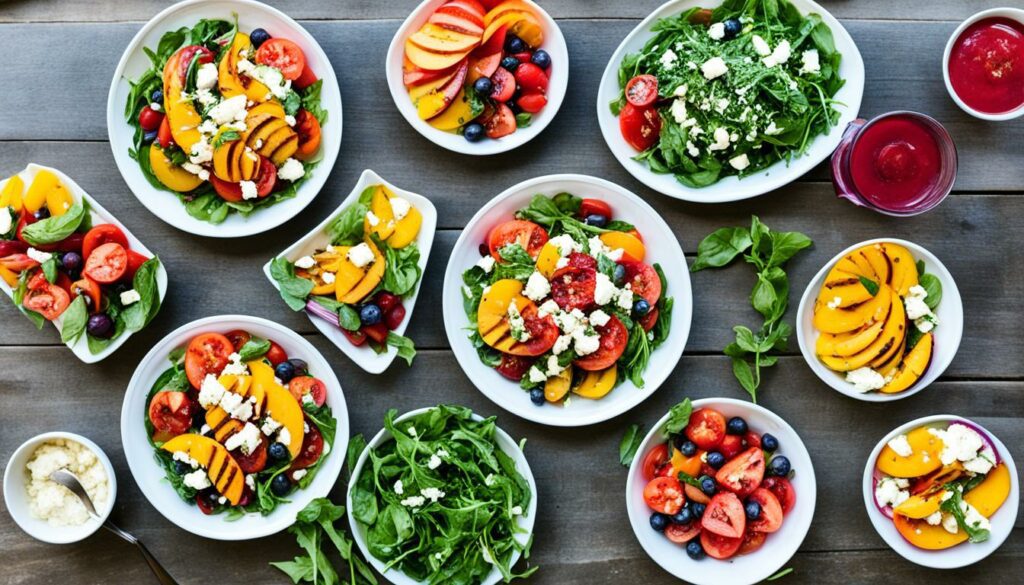
This recipe makes enough for four people and only takes ten minutes to prepare. You’ll need 2 large peaches and 2 large heirloom tomatoes. The ingredients for the Peach and Tomato Caprese Salad are simple:
| Ingredient | Quantity |
|---|---|
| Ripe Heirloom Tomatoes | 3-4 |
| Ripe Peaches | 2 |
| Fresh Mozzarella Cheese | 1 cup |
| Fresh Basil | Handful |
| Brightland Olive Oil | To taste |
Start by slicing the peaches and tomatoes. Gently grill the peach slices to make them sweeter. Then, mix them with creamy mozzarella and fragrant basil. A bit of Brightland Olive Oil unites the flavours. Add balsamic vinegar for a tangy twist.
This salad has been given a five-star rating by everyone who’s tried it. It’s perfect for a family BBQ or a gathering. It celebrates fresh ingredients from the market. You can mix it up by adding mint, burrata cheese, or maple syrup-coated grilled peaches. It’s easy to make, perfect for summer hosting, so you can enjoy the sunshine.
Want more ideas for your farmers’ market haul? The heirloom tomato recipe is versatile. It also makes a great topping for grilled bread. This simple dish turns any meal into something special. Use it as a springboard for your summer cooking.
This salad brings together farm-fresh chicken with a surprise – blueberries. It’s a mix of salty and sweet that you’ll love. It shows how using blueberries can make chicken salads special and tasty.
The recipe makes about 8 servings, great for family meals or preparing ahead. It uses 1 pint of fresh blueberries in the salad and another cup in the dressing. This makes a perfect blend. Each serving is full of good stuff and has around 510.75 calories. It gives you 33.61 grams of protein from the chicken.
This dish is not just tasty but also good for your health.
| Nutrient | Amount per Serving |
|---|---|
| Carbohydrates | 30.69 grams |
| Protein | 33.61 grams |
| Saturated Fats | 6.51 grams |
| Sugars | 24.58 grams |
| Sodium | 286.08 milligrams |
Blueberries are seen as a superfood because they are low in carbs. You can eat them any time of year because they freeze so well. To freeze them, spread them on a baking sheet until they’re hard, then put them in freezer bags.
The Blueberry Chicken Salad recipe is easy and tasty. You’ll need olive oil, white wine vinegar, garlic, salt, and pepper. Add chicken, carrots, celery, onion, and red bell pepper, plus salad greens and blueberries. It creates a lively and good-for-you dish that’s all about fresh ingredients.
This recipe with blueberries makes regular chicken salads new and exciting. It shows how using local fruits can lead to clever and tasty meals. Enjoy the mix of flavours and all the nutrition in this dish.
Organic food is key to making healthy meals. It offers many benefits. Foods made without man-made pesticides are better for us and the Earth.

Eating organic means choosing clean food. It’s packed with more essential nutrients than regular food. Here are a few reasons why:
Adding organic ingredients to my meals makes my diet healthier and more enjoyable.
Organic eating isn’t just about us but also the planet. It supports farming that’s good for the environment. It reduces our negative impact in several ways:
These benefits highlight how our food choices can help the Earth and our health. Let’s look at a comparison:
| Aspect | Conventional Food | Organic Food |
|---|---|---|
| Chemical Use | High | Low or None |
| Nutrient Density | Variable | High |
| Environmental Impact | Significant | Minimal |
| Support for Local Farmers | Low | High |
Going organic supports both our personal health and the planet. It shows we care about the environment and farming communities. Our diet and Earth’s well-being are connected.
My Homemade Rhubarb Cake celebrates the lively taste of spring. It’s a special recipe in my collection. This cake pairs the zing of fresh rhubarb with a soft, sweet batter. It’s great for those who love rhubarb desserts. Baking with what’s in season gives us a lovely dessert. This cake feels like a warm hug and tastes elegant.
| Time & Yield | Details |
|---|---|
| Preparation Time | 15 minutes |
| Cooking Time | 30 minutes |
| Total Time | 1 hour and 5 minutes |
| Yield | Feeds a crowd |
Here’s what you need for the batter:
For the cake, use 4 stalks of rhubarb, each about 15 inches long. For the topping, mix ¼ cup of softened butter with ¼ cup of flour. Add ¾ cup of sugar and ½ teaspoon of cinnamon. This topping makes the cake even better.
Rhubarb is sharp but it works wonders in this cake. It balances the batter’s sweetness. If you want something different, try using peaches or blueberries instead.
The outcome is more than just a dessert. It’s a homemade masterpiece that highlights farm-to-table cooking. This cake will be the star of any party. Baking with what’s in season brings a unique joy. And this cake proves that beautifully.
Starting an ethical eating journey means looking at the true nature of our food. We aim to make choices that are both good for our morals and the planet. This way of eating helps us bond with the food, the ways it’s made, and the people who make it.
Ethical eating is all about food integrity. It’s a promise to look after the Earth and all who live on it through what we eat. This means knowing how food production affects the environment, animals, and our local economies. It’s our effort to eat in ways that do the least harm and support sustainable food practices.
Choosing mindful eating means we make careful decisions every day. We think about where our food comes from and how it’s made. This could involve picking foods that are grown in eco-friendly ways. Or we might cut back on meat to lower our impact. Making ‘green’ food choices also means we back farmers who care for the Earth, aim to reduce pollution, and improve their food’s quality.
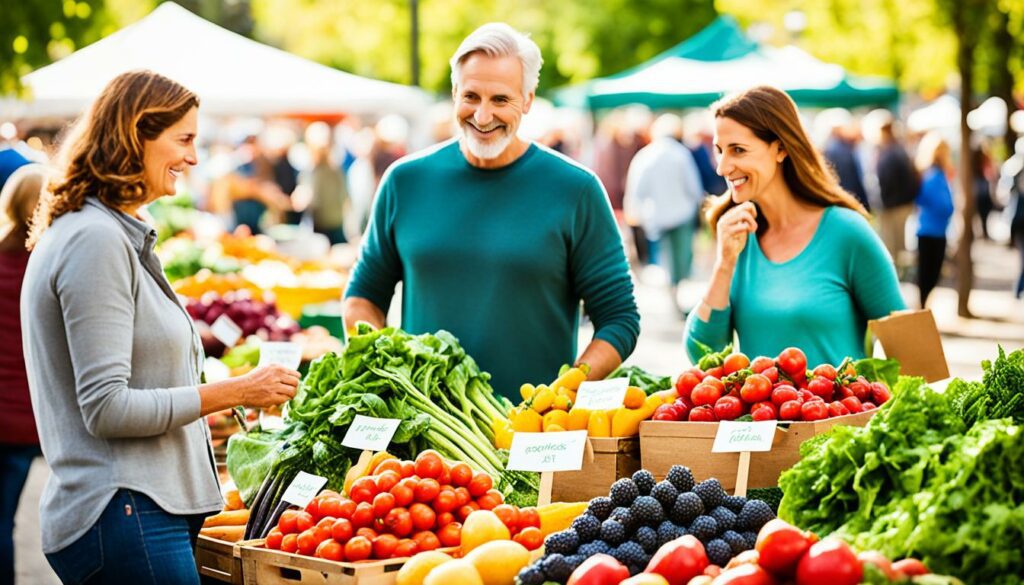
| Aspect | Description | Benefits |
|---|---|---|
| Farm-to-Table | Sourcing fresh ingredients directly from local farms. | Fresher meals, sustainable sourcing, supports local farmers. |
| Sustainable Practices | Use of regenerative agriculture and seasonal ingredients. | Reduces environmental impact, promotes biodiversity. |
| Ethical Meat Selection | Choosing pasture-raised, grass-fed meats. | Higher quality meat, environmentally friendly, humane treatment of animals. |
| Mindful Consumption | Eating with awareness of food origins and impacts. | Encourages healthier, more sustainable eating patterns. |
Weeknight dinners can still reflect farm-to-table ideals. They combine quick, simple recipes with nutritious and eco-friendly meals. Using local and seasonal ingredients makes sure every dinner is tasty and good for the planet.
Making quick farm-to-table dishes makes weeknight meals easy. Recipes like sausage and vegetables in one pot cut down on cooking and washing up. Making extra food to serve as leftovers simplifies things more. This method fits the busy lives of families and supports sustainable cooking.
Making healthy meals for kids is about adding fun and nutrition. Mixing fresh, colourful ingredients into their favourite meals makes them more likely to eat well. Imagine colourful taco bowls or oven-baked chicken fingers with a tasty side salad.
In the south, Peach Cobbler is a favourite and a classic. I use 6 large Jersey peaches from a 20-acre farm. They bring a sweet, juicy taste to this dessert.
It’s easy and takes just over an hour. Preparation is quick, and it bakes to a golden-brown in under 45 minutes. This dish turns fresh peaches into a work of art.
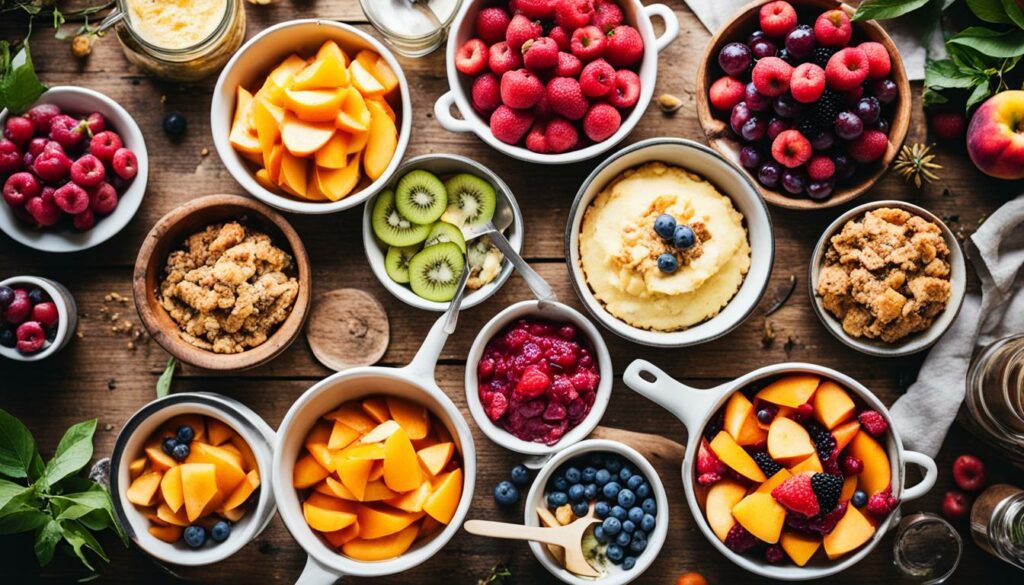
This recipe needs melted butter, flour, sugar, baking powder, salt, milk, peaches, and lemon juice. It’s been popular since July 2015, with 1.2K shares and 330 pins. People love to bake and share treats like this.
Peaches are light and low in fat but high in sugar. The USDA says they’re a healthy choice. Canned peaches are just as good as fresh, so this dish is good all year.
| Nutrient | Amount per 100g |
|---|---|
| Calories | 65 |
| Total Fat | 0g |
| Sugar | 11g |
This dessert smells amazing when it’s served. It stays good in the fridge for three days or can be frozen. You can make it lighter by using baking soda instead of powder.
To peel peaches easily, just boil them for a few seconds then put them in cold water. This helps the skin come off easily while keeping the inside juicy. The Peach Cobbler is a true taste of home, making every bite special.
Being a locavore can bring joy but needs skill in local food shopping. You can start by exploring farmers’ markets and joining community-supported agriculture (CSA) boxes. These have roots in Japan from the 1970s.You can find what’s in season easily online. For example, in British Columbia, enjoy asparagus in May, strawberries in June, and peaches in August.
Local food shopping isn’t just about farmers’ markets. Try a challenge to eat food only from within a 100-mile radius for a week. You’ll be amazed at the variety of local produce. For instance, you can get pink-eyed Warba potatoes from the Fraser River Delta in May. Or, tomatoes from Lillooet in August.Local farms offer nearly 300 types of pears. The nutrition and taste of these rare varieties usually beat those from big farms.
Knowing how to store fresh produce is crucial. It keeps the food quality high for longer. This is great for your farm-to-table meals.For the tastiest and most nutritious meals, store items like sweet corn from Chilliwack well. Also, look after the fantastic root vegetables from Pemberton Valley, available in the fall. These farm-to-table methods ensure your dishes are bursting with local and seasonal tastes.
Farm-to-table recipes use fresh, local ingredients to make tasty meals. They often include fruits like peaches, vegetables like zucchini, and watermelon. These are the types of foods you’ll find at your local market.
Farm-to-table cooking uses ingredients from nearby farms. This means the food is fresh and supports local farmers. It highlights the best flavours of the current season.
Local ingredients taste fresher and support the community. Choosing local helps farmers and the environment. It improves the quality of your food and reduces the distance it travels.
Eating what’s in season means you get the best taste and nutrition. Each season offers different fruits and vegetables. This makes your meals more interesting and healthy.
Sustainable farms help the environment and produce better food. They use methods that protect the land and its creatures. This leads to tastier fruits and vegetables.
The farm-to-fork movement is about eating food directly from local farms. It cuts down on the distance food travels to your plate. This choice is good for you and the planet.
Sure! Try the Grilled Peach and Heirloom Tomato Salad. It combines sweet peaches, tangy tomatoes, and fresh basil. This dish is easy to make and screams summer and local goodness.
Check out the Fresh Blueberry Chicken Salad. It pairs sweet blueberries with chicken. This recipe is both delicious and shows off the farm-to-table ethos.
Organic food is rich in nutrients and doesn’t use harmful chemicals. It’s good for your health and the environment. Choosing organic shows care for your body and the Earth.
Of course! Try my Homemade Rhubarb Cake. It blends the sourness of rhubarb with sweet cake. This treat is perfect for spring and farm-fresh goodness.
Eating ethically means making choices that are good for the Earth and its people. It’s about eating less meat, choosing sustainable foods, and being mindful. It shows respect for our world and others.
Yes, you can enjoy farm-to-table meals every night. Quick options are grilled sausage with veggies or chicken tetrazzini. These meals are simple, delicious, and perfect for busy families.
A Peach Cobbler is special with its juicy peaches and soft crust. It’s a taste of the South and home baking. This dessert showcases the best of the season in every bite.
To live the locavore life, shop at markets and co-ops. Learn how to store fresh foods to keep them at their best. This way, your meals reflect the local harvests and are full of freshness.